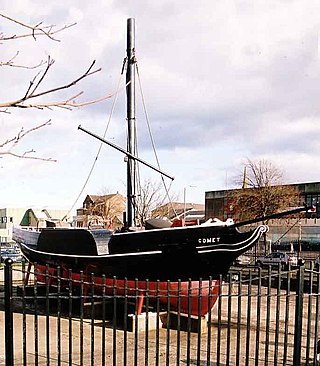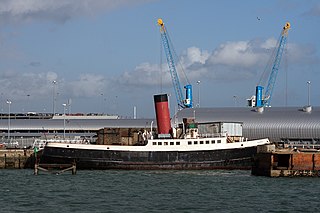
A steamship, often referred to as a steamer, is a type of steam-powered vessel, typically ocean-faring and seaworthy, that is propelled by one or more steam engines that typically move (turn) propellers or paddlewheels. The first steamships came into practical usage during the early 1800s; however, there were exceptions that came before. Steamships usually use the prefix designations of "PS" for paddle steamer or "SS" for screw steamer. As paddle steamers became less common, "SS" is incorrectly assumed by many to stand for "steamship". Ships powered by internal combustion engines use a prefix such as "MV" for motor vessel, so it is not correct to use "SS" for most modern vessels.

A steamboat is a boat that is propelled primarily by steam power, typically driving propellers or paddlewheels. Steamboats sometimes use the prefix designation SS, S.S. or S/S or PS ; however, these designations are most often used for steamships.

SS Yongala was a passenger steamship that was built in England in 1903 for the Adelaide Steamship Company. She sank in a cyclone off the coast of Queensland in 1911, with the loss of all 122 passengers and crew aboard.

PS Waverley is the last seagoing passenger-carrying paddle steamer in the world. Built in 1946, she sailed from Craigendoran on the Firth of Clyde to Arrochar on Loch Long until 1973. Bought by the Paddle Steamer Preservation Society (PSPS), she has been restored to her 1947 appearance and now operates passenger excursions around the British coast.

The PSComet was built in 1812 for Henry Bell, a Scottish engineer who with his wife had become proprietor of the Baths Hotel offering sea bathing in Helensburgh. On 15 August 1812, Bell's ship began a passenger service on the River Clyde, connecting Helensburgh to Greenock and Glasgow. This was the first commercially successful steamboat service in Europe. Bell obtained the engine from John Robertson of Glasgow, and the ship was built for him by John and Charles Wood of Port Glasgow.

SS City of Glasgow of 1850 was a single-screw passenger steamship of the Inman Line, which disappeared en route from Liverpool to Philadelphia in March 1854 with 480 passengers and crew. Based on ideas pioneered by Isambard Kingdom Brunel's SS Great Britain of 1845, City of Glasgow established that Atlantic steamships could be operated profitably without government subsidy. After a refit in 1852, she was also the first Atlantic steamship to carry steerage passengers, representing a significant improvement in the conditions experienced by immigrants. In March 1854 City of Glasgow vanished at sea with no known survivors.

Lobnitz & Company was a Scottish shipbuilding company located at Renfrew on the River Clyde, west of the Renfrew Ferry crossing and east of the confluence with the River Cart. The Lobnitz family lived at Chapeltoun House in East Ayrshire. The company built dredgers, floating docks, fishing boats, tugs and workboats.

William Denny and Brothers Limited, often referred to simply as Denny, was a Scottish shipbuilding company.

Stella was a passenger ferry in service with the London and South Western Railway (LSWR). She was built in Glasgow in 1890, and wrecked in 1899 off the Casquets during a crossing from Southampton to Guernsey.

SS City of Launceston was a 368 GRT steamship operated by the Launceston and Melbourne Steam Navigation Company from 1863, which had an early role in colonial steam shipping as the forerunner of the modern Bass Strait ferry service between Tasmania and Victoria. It was sunk in Port Phillip Bay after a collision with another ship on 19 November 1865.

The Port of Southampton is a passenger and cargo port in the central part of the south coast of England. The modern era in the history of the Port of Southampton began when the first dock was inaugurated in 1843. After the Port of Felixstowe, Southampton is the second largest container terminal in UK, with a handled traffic of 1.5 million twenty-foot equivalent units (TEU). It also handles cruise ships, roll-on roll-off, dry bulk, and liquid bulk.

SS Sirius was a wooden-hulled sidewheel steamship built in 1837 by Robert Menzies & Sons of Leith, Scotland for the London-Cork route operated by the Saint George Steam Packet Company. The next year, she opened transatlantic steam passenger service when she was chartered for two voyages by the British and American Steam Navigation Company. By arriving in New York a day ahead of the Great Western, she is usually listed as the first holder of the Blue Riband, although the term was not used until decades later.

SS Prinz Friedrich Wilhelm was an ocean liner for North German Lloyd (NDL) from her launch in 1907 until the end of World War I. After the war, she briefly served as USS Prinz Friedrich Wilhelm (ID-4063) for the United States Navy returning American troops from France. The vessel was first chartered—and later purchased outright—by Canadian Pacific Steamships (CP) and operated under the names Empress of China, Empress of India, Montlaurier, Monteith, and Montnairn. She was scrapped in 1929.
MV Domala was a British cargo liner that was launched in 1920 as Magvana, but completed in 1921 as Domala. She was the first major ocean-going passenger ship to be built in the United Kingdom as a motor ship.

TSS T/T Calshot was a tug tender built in 1929 by John I Thornycroft & Co, and completed in 1930 for the Red Funnel Line. Calshot was one of only three surviving classical tender ships which served the great ocean liners, another example is the SS Nomadic, which tendered the ill-fated RMS Titanic on her maiden voyage at Cherbourg, France. The third being the Manchester Ship Canal's Daniel Adamson. In her career, Calshot has tendered some of the most famous ocean liners ever built, such as the RMS Caronia, the Cunard Queens RMS Queen Elizabeth and RMS Queen Mary, the SS United States, and the White Star Line ship RMS Olympic. During World War II she was requisitioned by the British Admiralty for servicing troop ships and took part in D-Day. She was a registered vessel of the National Historic Fleet of the United Kingdom, holding Certificate No. 1.

Steam-powered vessels include steamboats and steamships. Smaller steamboats were developed first. They were replaced by larger steamships which were often ocean-going. Steamships required a change in propulsion technology from sail to paddlewheel to screw to steam turbines. The latter innovation changed the design of vessels to one that could move faster through the water. Engine propulsion changed to steam turbine in the early 20th century. In the latter part of the 20th century, these, in turn, were replaced by gas turbines.
Mohawk was a passenger cargo steam turbine-powered ship built in 1925–1926 by Newport News Ship Building & Drydock Co. of Newport News for Clyde Steamship Company with intention of operating between New York and Jacksonville. She was luxuriously equipped, and regularly carried celebrity passengers. In 1929, her schedule was extended to Galveston, and she also operated winter cruises to various Caribbean destinations. On 24 January 1935, after leaving New York City on one of her regularly scheduled trips, she suffered a failure of her automatic steering gear and collided with Norwegian cargo ship Talisman. Mohawk sank after about an hour with a loss of 31 crew and 16 passengers.
SS Baltimore was an iron passenger steamship of the North German Lloyd line, built by Caird & Company of Greenock, Scotland in 1867. She was used for most of her career to bring German immigrants to Baltimore.

Glasgow Corporation Water Works and its successors have provided a public water supply and sewerage and sewage treatment services to the Scottish city of Glasgow. There were several schemes in the early part of the 1800s, with the Glasgow Company which was established in 1806 pumping filtered water from the River Clyde into the city. The Gorbals Gravitation Water Company was established in 1846, and brought water from reservoirs to the south-west of the city. However, an outbreak of cholera in 1848/1849, in which 4,000 people died, concentrated the minds of Glasgow Council, and in 1855 a scheme to use water from Loch Katrine, 36 miles (58 km) to the north, was authorised. The work required at Loch Katrine was quite modest, and the major construction work was the building of an aqueduct to carry the water to the city by gravity.

MV Gardyloo was a specially designed sewage dumping vessel that operated from Leith between 1978 and 1998. The ship's name is an 18th-century word derived from the French "gardez l’eau", used in Edinburgh to warn passers-by of waste about to be thrown from a window into the street below. Prior to 1978, the city of Edinburgh's waste was discharged into the Forth from a series of eight outlets along the coastline, where it often washed back up on beaches and rocks.




















